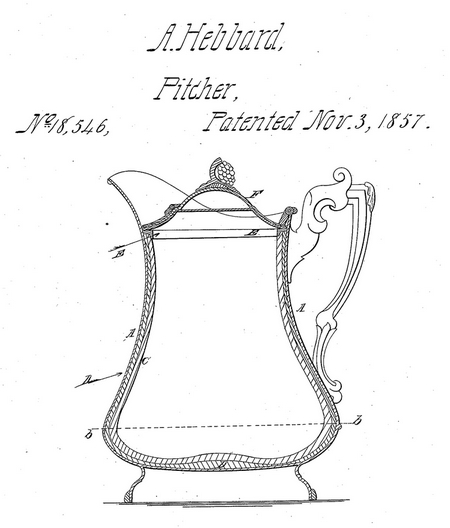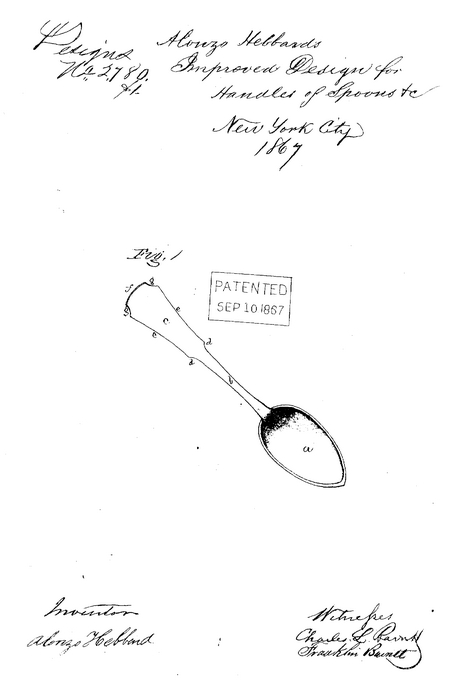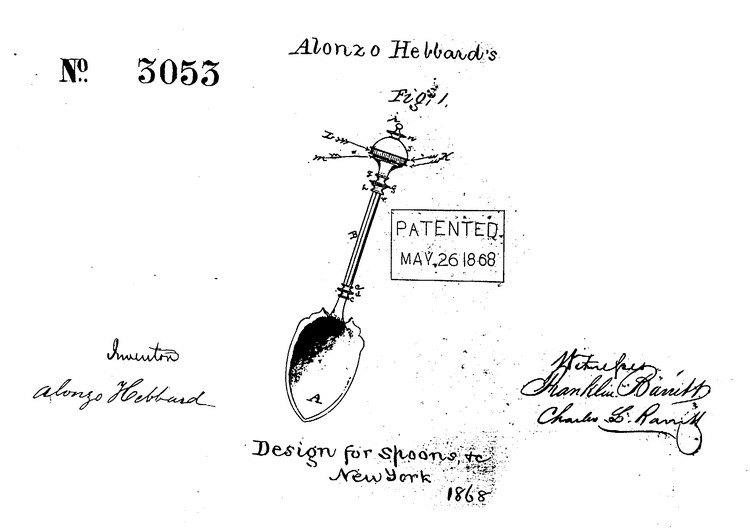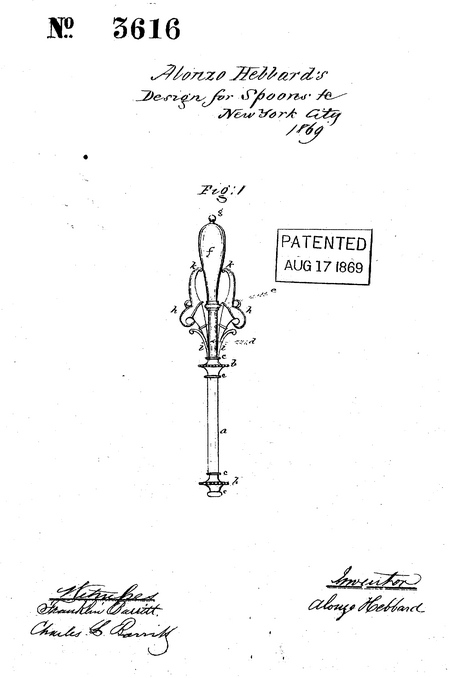|
Alonzo Hebbard
General notes:
Silversmith and designer
Events in his life were:
- He appeared on the census in 1850 in New York City NY. Listed as a silversmith.

- He was issued patent number 18,546 on 3 Nov 1857
ALONZO HEBBARD OF NEW YORK, N. Y.
IMPROVED WATER-COOLING PITCHER.
Specification forming part of Letters Patent No. 18,546, dated November 3, 1857.
To all whom it may concern:
Be it known that I, Alonzo Hebbard, of the city, county, and State of New York, have invented certain new and useful Improvements in Water-Cooling Pitchers; and I do hereby declare the following to be a full description of the same.
The nature of my invention consists in the use of the combination of a woolen felt covering of an interior porcelain or glazed pitcher with the said interior porcelain or glazed ware pitcher and an external metallic shell or pitcher for the purpose of making a frigorific pitcher and at the same time of great lightness as well as non-destructibility from the action of lemonades or other acidulated articles or liquids used as cooling, drinks or for other purposes; but to describe my invention more particularly I will refer to the accompanying drawings, forming a part of this specification, the same letters of reference wherever they occur referring to like parts.
Figure 1 is a vertical cut-section of the pitcher, showing by the different-colored lines the several parts.
Letter A is the shell of the pitcher, which may be made of any suitable material for such purposes, and of such size and shape as may be required. This shell is made in two parts, as shown by the dotted line b. The object of this is to facilitate the insertion of the interior pitcher in the shell.
Surrounding the earthen or porcelain pitcher C is a covering of felt D. This may be woolen cloth of one or more thicknesses, or of felt cloth of sufficient thickness to fill the entire space between the shell and porcelain pitcher, say to the thickness of one-fourth of an inch, more or less. The object of this felt covering is threefold: First, wool felts are among the best non-conducting substances known of ; second, it is of less weight in proportion to its non-conducting properties than any other substance for such purposes that can be found, and, third, it is elastic, and consequently affords greater protection to the exterior porcelain pitcher against fracture from external causes than could be obtained from any known material that could be used. The great desideratum in pitchers for this purpose is a tasty style combined with portability or lightness as well as frigorific properties, and to obtain these results it is believed no other combination of substances is better adapted or ever before used.
To protect the upper edges of the felt and porcelain pitcher from the action of the liquids when being poured in or out of it, a flange . E is soldered to the inside of the neck of the shell, which is luted or cemented down upon and over the edges of the porcelain pitcher, and thereby securely protects it from the action of the liquids or from getting in between the shell and interior pitcher.
Letter F is the cover attached to the shell and operated by a hinge in the usual way with covered pitchers.
Having now described my invention and its mode of construction, I will proceed to set forth what I claim and desire to secure by Letters Patent of the United States.
What I claim isó
The use of the combination of the woven cloth or felt covering as an elastic non-conducting packing for a porcelain or glazed ware pitcher with the said porcelain or glazed ware interior pitcher and external metallic shell or pitcher, for the purpose of making a a water-cooling pitcher, as hereinbefore set forth.
Alonzo Hebbard
Witnesses:
William Charters
Thomas Charters

- Patent: 2,780, on 10 Sep 1867. ALONZO HEBBARD, OF NEW YORK, N. Y., ASSIGNOR TO EDWARD CORNING AND J. W. DOMINICK, OF SAME PLACE.
Design No. 2,780, dated September 10, 1867.
DESIGN FOR A SPOON-HANDLE.
To All Whom It May Concern:
Be it known that I, Alonzo Hebbard, of the city, county, and State of New York, have invented or produced a new and original Design for the Handles of Spoons, Forks, and other articles of table cutlery; and I do hereby declare that the following is a full description of the same.
The nature of my invention consists in making the handle with a broad, rounded upper end, with the corners scalloped out so as to form sharp angles with the concave sides of the handle.
But to describe my invention more particularly I will refer to the accompanying drawings, forming a part of this specification, the same letters of reference, wherever they occur, referring to like parts.
Figure 1 is a front view of the spoon.
Letter a is the bowl or blade of the spoon, and b the stem thereof. Surmounting the stem is the handle c, which is slightly enlarged at the point of its junction therewith, so as to form abrupt angles or corners, d d, as a support for the lower end of the handle. The shape of this handle is somewhat like an inverted cone, having its sides e e curved slightly inwards. The upper end or base of the cone f (as it may be called) is formed with an outward curve, the corners g of which are scalloped out to meet the curved side lines of the handle, and thus form the base of the cone or head of the handle into curved outlines and abrupt angles or corners, to give to the handle of the article uniqueness of design and elegance of finish.
I claim the pattern or design of the handle of a spoon, fork, or other article of table cutlery, hereinbefore set forth and shown.
Alonzo Hebbard
Witnesses:
Charles L. Barritt
Franklin Barritt

- Patent: 3,053, on 26 May 1868. ALONZO HEBBARD, OF NEW YORK, N. Y., ASSIGNOR TO EDWARD CORNING, OF SAME PLACE.
Design No. 3,053, dated May 26, 1868.
DESIGN FOR A SPOON OR FORK-HANDLE.
TO ALL WHOM IT MAY CONCERN :
Be it known that I, Alonzo Hebbard, of the city, county, and State of New York, have invented or produced a new and Ornamental Design or Pattern for Spoons, Forks, and other articles of tableware or cutlery; and I do hereby declare that the following is a full description of the same, reference being had to the accompanying drawings, forming a part of this specification, the same letters of reference, wherever they occur, referring to like parts.
Figure 1 is a front view of the spoon.
Letter A represents the bowl or blade of the spoon. B is the stem or handle of the spoon, the sides of which are sexagonal in form. At or near its junction with the bowl are formed circular collars, c, d, and e, of which the middle one, d, is a little larger in diameter than the others, and has a gnarled edge, and at its upper end, at its junction with the head of the handle, a similar gnarled collar,/, supported on either side by circular collars, g and h. Surmounting the end of the stem is a dome-shaped head or capital, J, having two thin bands, K, around its base, and the intervening space between them subdivided into numerous vertical lines, L. Underneath the lower band is formed a collar, m, having its edge gnarled,-so as to form a bead-like base for the support of the dome and connection with the stem. Surrounding the dome is a gnarled-edged button, n. which is finished or surmounted by a small bead-like head, p, to complete the general design of the spoon.
Having now described my invention, I will proceed to set forth what I claim and desire to secure by Letters Patent of the United States.
I claim the design for the handle of a spoon, fork, &c. as described and shown.
ALONZO HEBBARD
Witnesses:
Franklin Barritt
Charles L. Barritt

- Patent: 3,616, on 17 Aug 1869. ALONZO HEBBARD, OF NEW YORK, N. Y.
Design No. 3,616, dated August 17, 1869.
DESIGN FOR HANDLE OF SPOONS.
To all whom it may concern:
Be it known that I, Alonzo Hebbard, of the city, county, and State of New York, have invented or produced a new and original Design for the Handles of Spoons and Forks, and other articles of table-cutlery; and I do hereby declare that the following is a full description of the same, reference being had to the accompanying drawings, forming a part of this specification.
Figure 1 is a representation of the handle of the spoon, without the bowl or blade attached thereto.
Letter a represents the lower half of the stem or handle of the spoon, of a sexagonal form, and having on it, at its shank or point of junction with the bowl, a thin button-shaped collar, b, with a bead-like edge, and supported or strengthened at each side of the button by collars c, with smooth edges, and of less diameter than the collar b.
At the upper end of the stem a is also attached a button with a bead-like edge, and supported by smaller collars, as just described, as forming the base, upon which is constructed the part commonly called the shield of the handle of a spoon. This part is composed of a central cylindrical stem, d, having on it, at midway of its length, an oval-shaped ferrule, e, and terminating at the top in a drop-like head, f, and surmounted by a small globular-formed button, g.
At each side of the central stem d is arranged a figure, h, representing an Egyptian lotus, the stem i of which unites with the central stem d, at its junction with the button forming the head or upper end of the stem a, and the inner point k, of the lotus-leaf or flower, is attached to the sides of the drop f, and thus secures the flower to the handle to complete the. design.
Having now described my new design for the handles of spoons, folks, and other articles of table-cutlery, I will proceed to set forth what I claim, and desire to secure by Letters Patent of the United States.
I claim the new and ornamental design for the handles of spoons, forks, and other articles of table-cutlery, as hereinbefore described.
Alonzo Hebbard
Witnesses
C. L. Barritt
Franklin Barritt

- He was issued patent number 134,600 on 7 Jan 1873
ALONZO HEBBARD, OF NEW YORK, N Y.
IMPROVEMENT IN STOPPERS FOR VOLATILE-SALTS BOTTLES.
Specification forming part of Letters Patent No. 134,600, dated January 7, 1873.
To all whom it may concern:
Be it known that I, Alonzo Hebbabd, of the city, county, and State of New York, have invented a certain new and useful Improvement in Stoppers for Volatile-Salts Bottles and other purposes; and 1 do hereby declare the following to be a full description of the same.
The nature of my invention consists in combining with a hollow screw-cap a perforated diaphragm, having in the center part of it a plug, of rubber or leather or other suitable material, to close the mouth of the bottle when screwed down upon it, and open it when unscrewed a turn or two to allow the escape of the volatized salts through the perforationsof the diaphragm to the outlet of the stopper. But to describe my invention more particularly, I will refer to the accompanying drawing forming a part of this specification, the same letters of reference, whenever they occur, referring to like parts.
Figure 1 is a side view of the bottle with stopper attached thereto. Fig. 2 is a cut sectional view of the same through the line x x, Fig. 1, showing the mouth of the bottle closed by the stopper. Fig. 3 is the same cut sec-sectional view, showing the mouth of the bottle open. Fig. 4 is a plan view of the diaphragm and plug of rubber therein on the line x2 x2. Fig. 3.
Letter A represents the bottle, which may be made of metal, glass, or other suitable material, having screw-threads B cut on the neck thereof, and its central opening 0 slightly projecting above the line of the screw-threads. The object of making the edges of the central opening C more prominent than the screw part of the neck of the bottle is to obtain a better surface to stop the opening than if made with a broader surface; and, second, to make the opening small enough to admit of the escape of the vaporized salts around the stopper D without making the screw-cap E disproportionately large to the size of the bottle. This screw-cap is made of metal, of a dome or any other suitable shape, with a central opening, F, at the apex of it. Across its internal diameter, about on a line with the spring of the arch of the dome, is firmly secured a diaphragm, G, having a number of perforations, H, through it, and surrounding a central cavity in which is inserted a plug of India rubber or leather, I, or other suitable material. The object of this plug is to act as a stopper to the opening in the neck of the bottle when the cap is screwed down, as shown in Fig. 2; and the perforations H are for the purpose of allowing the volatilized salts to escape from the bottle past the stopper, as shown by the arrows in Fig. 3, without the necessity of detaching the cap entirely from the neck of the bottle.
By this means it will be obvious that there can be but little risk of loss of the cap, and at the same time it affords a most perfect means for stopping the mouth of the bottle.
Having now described my invention, I will proceed to set forth what I claim, and desire
to secure by Letters Patent of the United Statesó
The combination of the bottle A with the screw-cap E, having a diaphragm, G, therein,
made as described, and all arranged and operating as set forth.
Alonzo Hebbard
Witnesses:
H. B. Dominick
Charles L. Barritt
|









